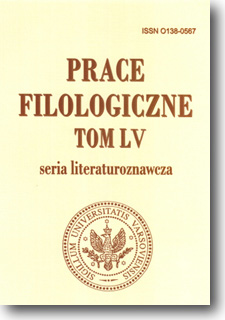Kresy. Szkic o dziejach pojęcia
The Borderlands (“Kresy”). A Sketch of the History of the Term
Author(s): Jacek KolbuszewskiSubject(s): Language and Literature Studies
Published by: Wydział Polonistyki Uniwersytetu Warszawskiego
Keywords: kultura polska; Kresy; Polish culture; Kresy (the Eastern Borderlands)
Summary/Abstract: The territory of the Eastern Borderlands of the former Republic of Poland, as early as in the second half of the nineteenth century, became an object of strong idealization, rooted in the old Polish “Ukrainian myth” anticipating the borderland mythology and idealizing the heritage of Ukraine as an integral part of Poland. The term “kresy” which refers to some part of the Eastern Borderlands, has a different scope of meaning than the terms that refer to similar areas in other languages. French “confins”, English “borderland”, German “Grenzland”, Latvian “pierobežas apgabali” and Slovakian “pohranicˇie” are direct equivalents of the Polish word “pogranicze” and, no doubt, in some context they may be used metaphorically. However, they differ from the term “kresy” lacking some extra mythological and symbolic meaning which makes Kresy an object of mythologization. It was in the poetry of Wincenty Pol that the term “kresy” acquired its metaphorical dimension. In {Mohort}, his chivalric poem which was written in the years 1840-1852, published in Cracow in 1854, and enthusiastically received afterwards, Pol exploited the existing military and legal term “kresy”, which was at first emotionally neutral, enriching it with a strong emotional status. Pol borrowed this term from his informers who told him the history of both: the authentic and the legendary “last knight of the Polish Republic” - Mohort, who had been killed at a venerable age during the battle with the Russians in 1792. The term “kresy” as referring to the furthest South - the Eastern Borderlands of the Polish Republic was coined as a result of a shift in reference of a term that was military in its origin, and meant - troops defending the border and distributing the mail orders - to include the territory of the entire Ukraine. In this sense, the term “Kresy” became an axiological category. Yet in the nineteenth century, its scope and meaning further expanded to cover those western areas were Polish ownership was threatened (J. Zachariasiewicz, 1860). However, the process of expanding the range of the term’s reference (in spacial terms) did not take place until the beginning of the twentieth century, the time of Polish - Ukrainian military conflicts in particular, when Lviv started to be perceived as the “kresy” fortress. It was also then that Vilnius and the surrounding area began to be perceived as “kresy”. The term “kresy” referring to the eastern territories of independent Poland was significantly extended then. On the other hand, the propagandist attempts to apply this term to western and northern Poland were unsuccessful. After the World War II, at the time of the Polish People’s Republic, the term “Kresy” was utterly eliminated from the public language, the language of politics, literature, journalism, science, art and {toto genere} culture due to censorship reasons.
Journal: Prace Filologiczne
- Issue Year: 2008
- Issue No: 55
- Page Range: 15-30
- Page Count: 16
- Language: Polish

